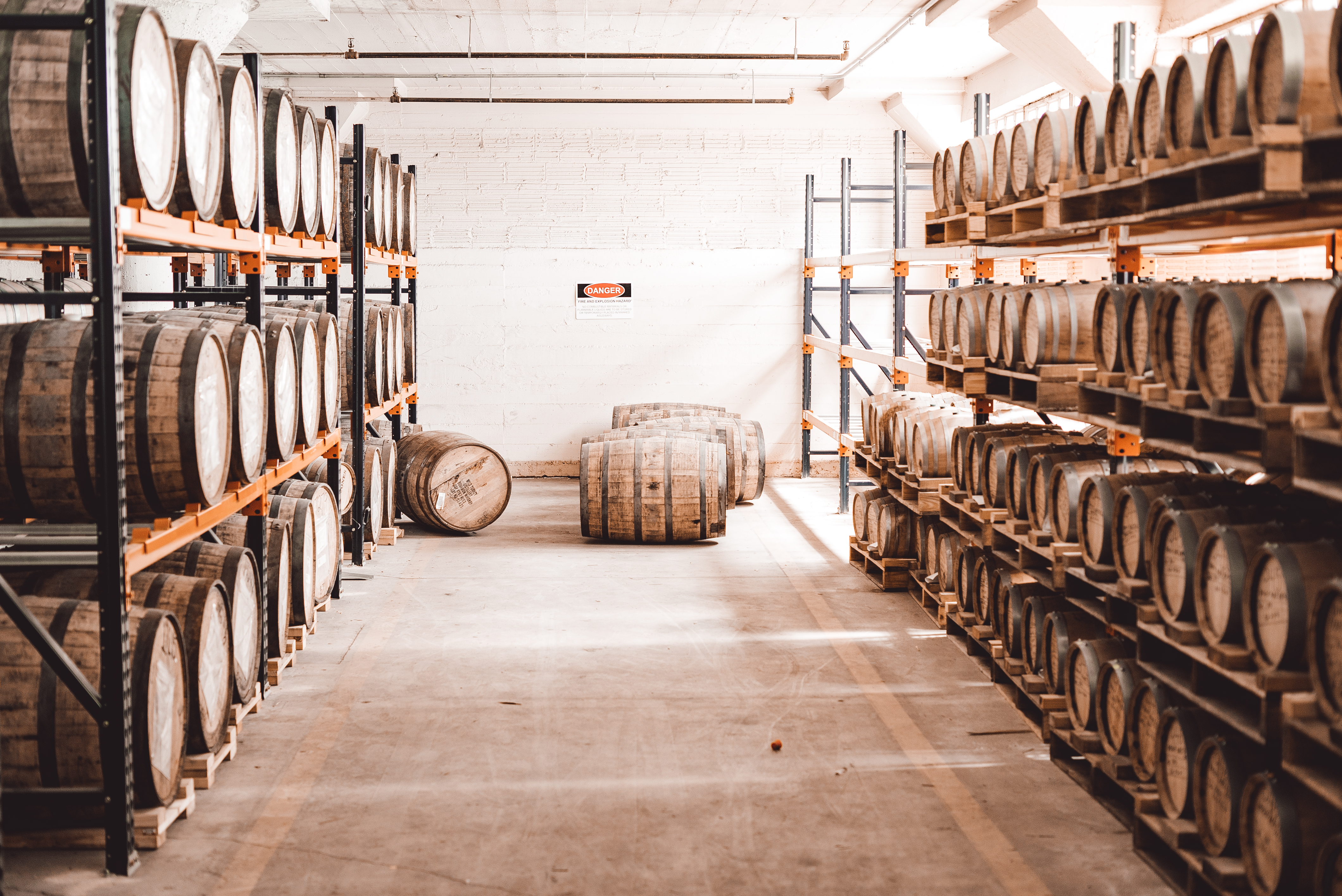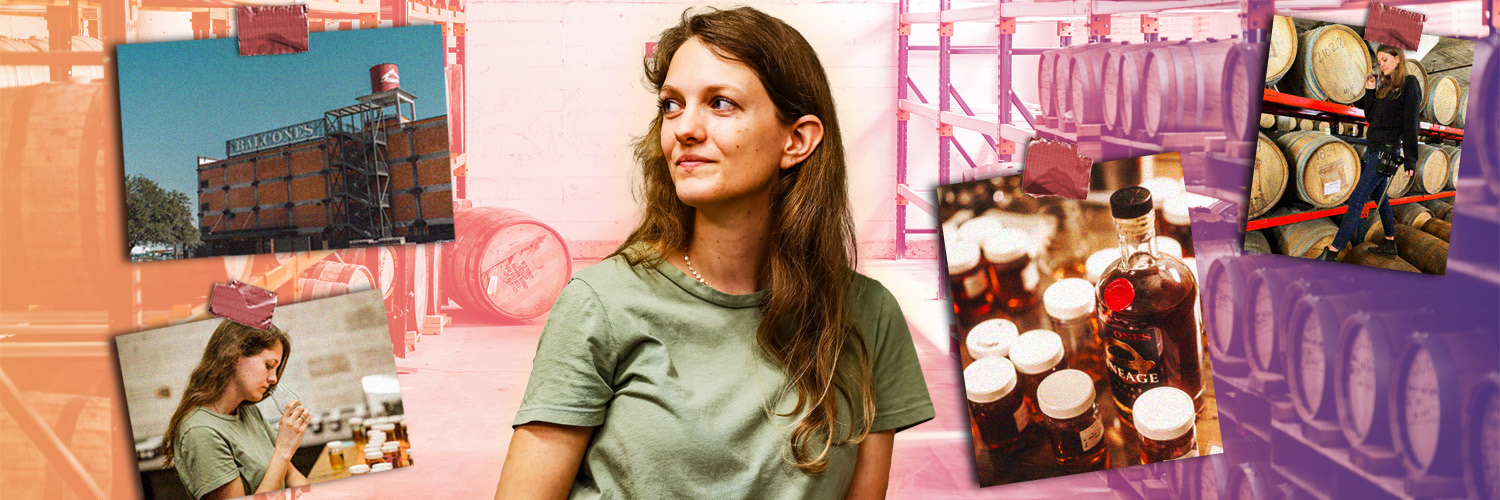What does it mean when someone “blends a whiskey?” My goal with this piece is to answer just that, while also dispelling some old myths about what whiskey blending is and isn’t. I was lucky enough to get some help on this journey from one of my favorite brands, Balcones, and their blender Emma Crandall.
Before we dive into the nitty-gritty, let’s lay down a few foundational facts. All whiskeys are a blend of barrels unless they’re labeled “single barrel” or “single cask.” A batch of whiskey is a blend of barrels from the same distillate/style. So all the barrels in a “straight bourbon whiskey” has to be straight bourbon whiskey that’s blended from sometimes hundreds or even thousands of barrels.
Likewise with “single malt Scotch whisky,” all of the barrels blended into a batch of single malt need to be single malt Scotch whisky from the same distillery. But “blended Scotch whisky” or “blended American whiskey” or sometimes just “bourbon whiskey” represent a blend of different types of whiskeys/spirits. Blended Scotch whisky is usually a blend of single malt and single grains whiskies. Blended American whiskey is often (but not always) a blend of bourbon and neutral grain spirit or unaged whiskey.
To be very clear, Emma Crandall and I will be discussing the former. We’re discussing how multiple barrels are blended to create a “batch” of whiskey. In this case, we’re breaking down how Balcones’ beloved Lineage Texas Single Malt Whisky is built, blended, and made.
Crandall was kind enough to jump on a call and break it all down from a true insider’s perspective. So, let’s dive in and learn how a batch of whiskey is really built by someone doing that work on the day-to-day level.
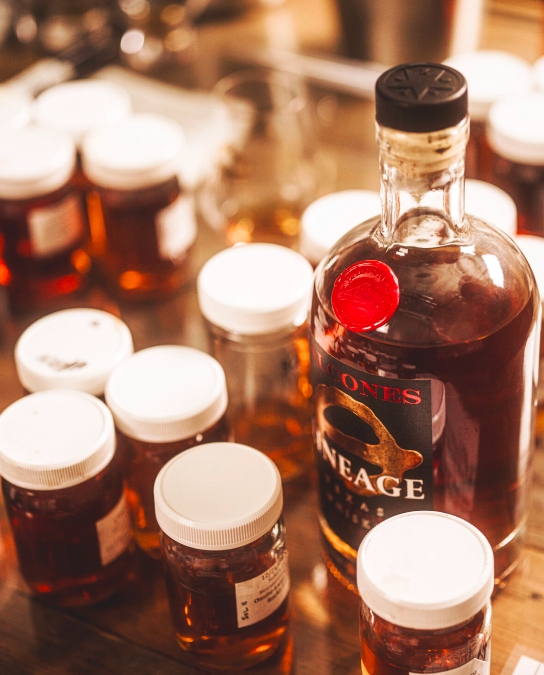
When you’re looking at blending, what are the sort of details that you’re looking for when you start to build something out? Is it a matter of finding barrels that fit a profile? Or is it more seeing what you have that you can use to find new paths?
It’s a little of both of those things. I can take you through an entire blending process, what that would look like, start to finish with one of our core blends, Lineage. I’ve gotten to be able to be more and more involved in each step of that process, and I’m really grateful they made me officially a blender. I’m no longer an assistant anymore, which is really exciting.
Congratulations! And awesome, let’s walk through how Lineage is made.
So, when we’re first beginning a batch, we have this software that shows us our entire warehouse, and it’s a more visual way of looking at our warehouse. We can filter it in a very customized set of directions and filters. When we are thinking about starting a Lineage blend, we will look at, “Okay. Well, this is made from Scottish barley and Texas barley.” We’ll look at all of that stock, we’ll filter it by age statement to make sure we’re only looking at things that are in the right age.
Then, we will filter it on barrel type. For Lineage particularly, we’re looking at used casks that could be American oak, European oak, or French oak. We also have used Kentucky barrels because they’re used casks. We look at what’s been used in them before. We have this function in Whisky Systems — which is the database that we use right now for reporting — where you can record barrel notes. We keep track of if something’s been transferred into a different cask, or if maybe someone tried it and took particular tasting notes that were different from the typical trend of that spirit type, we might record that in a barrel note.
We’ll pull a list of barrel numbers that could be Lineage. It doesn’t mean they’re going into this batch, but they could be. We send that list off to our warehouse team and they pull all of the samples for us. Once they bring those up to the blending room, we will separate and organize all of the samples in little 100 ml vials and we’ll separate and organize them based on the criteria that I just mentioned to you. So, we’ll separate the American oak, European, French oak, and used Kentucky barrels.
With malt, we get really granular and so we will sample each individual barrel and take sensory data on them. We have these little charts that have a section for the nose and a section for the palette. We’ll take notes on the aromas and flavors, descriptors, and texture. We’ll make a note if there are any flaws and if we think any mitigation needs to happen for that cask, and we’ll kind of tier them with tier one being the most promising up front. That’s probably what we’re going to end up using in the batch. And then tier three being maybe something problematic that needs mitigation, or it could just be that the flavor profile doesn’t match. Maybe it’s more of a Texas One blend versus a Lineage blend kind of cask.
That’s kind of the crapshoot, isn’t it? Or have you found more consistency in the barrels?
There are some things like production changes that have happened over time where we’re finding more consistency in some avenues versus others. We’ve found which barrels we like to fill. We’re also starting to have more patterns of what works for us and what doesn’t work as well. That’s been really helpful. We’re hitting our 15-year anniversary of Balcones, and so it’s nice to have some patterns to help along the way.
Wow, 15 years, time flies. So back to building out the blend. What happens next?
We’ll take all those tier-one casks and we’ll build a base out of that. We will pretend like every cask has an equal amount of volume in it as we’re working this tabletop base — our in-lab blend — because we don’t know every cask’s fill level versus its evaporation rate. We’ll go like one to one. Once we’re happy with a tabletop base, we’ll send those numbers off to the warehouse team and they dump it for us.
They bring us a sample of the dumped base, and then from there we can spike it and tweak it as needed. Sometimes we’re really close, and maybe we don’t do anything to it, or we add one or two casks and sometimes it takes a bit more work.
Right. I imagine some casks are emptier than others and that throws a monkey wrench in everything.
It always amazes me. We’ll get messages from the warehouse team saying, “Hey, it turns out this cask had a really bad leak and it’s almost empty.” Even that one cask of, say, a hundred, can make a huge difference sometimes. That’s always a beautiful and frustrating surprise sometimes.
So more often than not, we’re going to have to tweak the base in the lab to adjust the tabletop base we’re working on. Once we’re happy with that kind of tabletop, again, we’ll mix the barrels we think we need to add into the base on a tabletop. Then we will send that to the warehouse. They’ll dump it again, and we’ll keep doing that process until we get to a final blend. Then we’ll approve it and it goes through the bottling process and all of that.
All of that makes Lineage my favorite release to blend at Balcones because there are so many different kinds of barrel types that we work with. I really like looking at the Texas multi-barley that we put in there. It just has a lot of fun parts to it and it feels the most like a puzzle, if that makes sense.
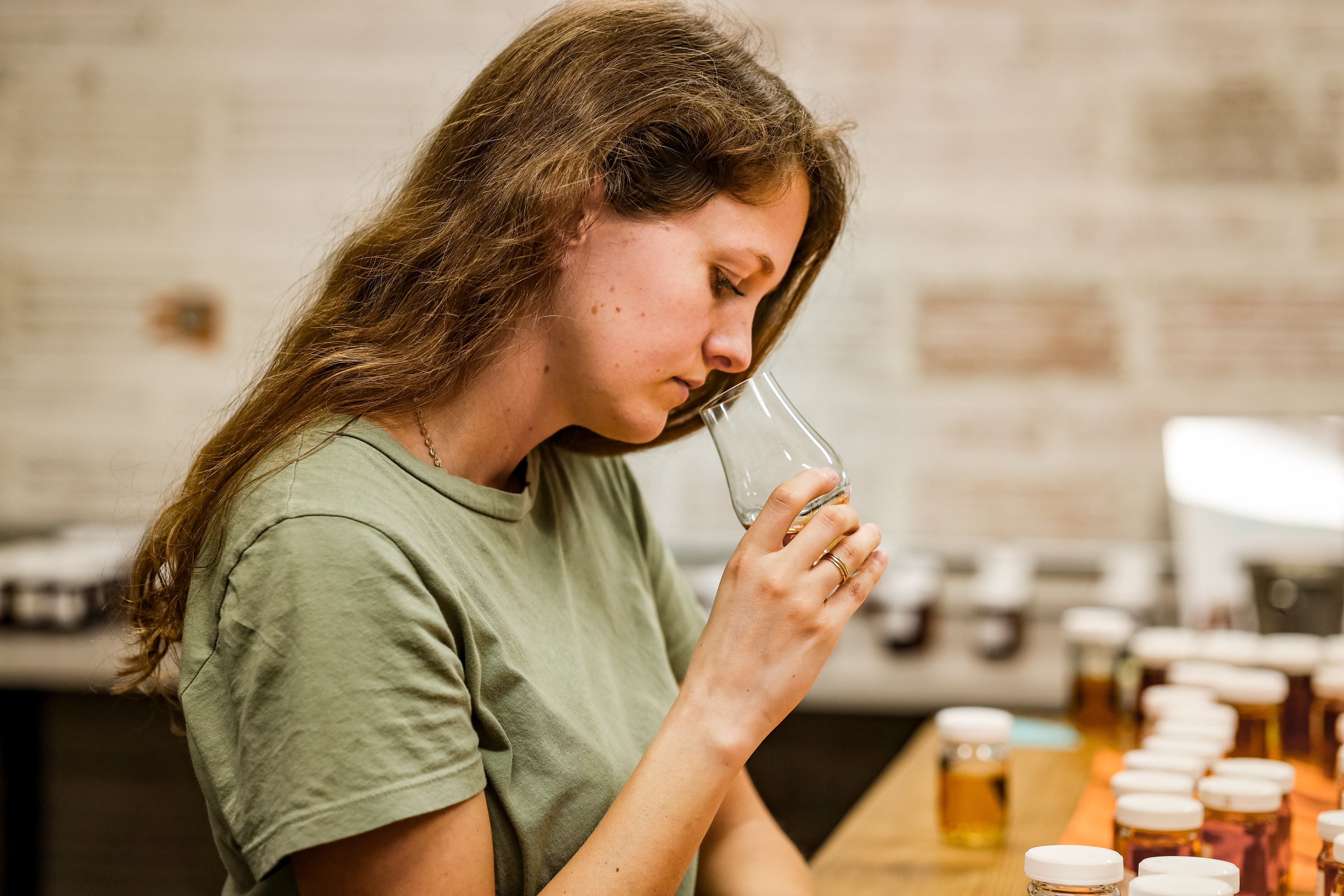
So let’s take a small step back, or wider, I guess. How do you keep that continuity between batch after batch? How far back do you go with releases to keep a throughline?
It’s very interesting. What we’ll do is when we’re starting the blend, we will pull out the last three batches and do sensory analysis on those. It’s surprising even after having finished a blend and returning to it a year later, there are moments where I think, “Oh, that’s a little woodier than I remembered it being,” or, “Oh, so nice. This batch has developed so nicely.” As we’re going through, we’re keeping in mind that profile. We’ll point out all the things we like and don’t like about previous batches.
For some of our releases, we might be thinking of the direction we want to take it if it’s kind of changing in ways we didn’t foresee. We want to do that slowly over time rather than all at once. With Lineage, there are moments where it’s like we’re doing our table talk and even though we’re picking some of the best casks for it, it might be like, “Oh, that’s kind of prickly or spicier. It has this white spice kind of note to it that we want to avoid.” There’s definitely a level of, “Here is our Lineage profile, and we want to showcase this.”
We want consumers who love Lineage to know they can return to it and it will still be Lineage. But we also will come across moments where we find tasting notes in that process that aren’t typical. Sometimes we get a little gingery note on the finish that we try to avoid highlighting too much in our blends. Anytime we find really beautiful stone fruit — that’s all over our whiskeys — we want to hold onto it. But we have to ask: Is it stone fruit versus cooked down to the caramelized sugars from peaches or tropical fruit? All of those different kinds of fruit categories have a different release vein in our heads. Mirador, you think more tropical fruit. Texas One kind of has more of that. With that virgin oak, you just get more density from it and it shows more fruit. Lineage has more for those light and delicate fruits but they still present as peach, apricot, and fresh fruit notes.
I love those fruit notes in Balcones. So getting a little more granular, let’s talk water in building a blend. Naturally, each barrel is going to have a slightly varied ABV or proof so what are you proofing each one down to when you sample them in the tasting lab?
The moment we start sampling individual barrels, we are proofing each sample down to 47-proof. Since we know that this is the bottling proof, we’re doing everything at that proof. Because you could blend something at cask and then proof it down and it does not do what you think it will do.
When we know the bottling proof, we will always blend and sample to the bottling proof. It isn’t until we get more towards special releases or new releases we haven’t done before that it’s like, “Okay, well maybe let’s try this at cask strength, and see and go from there.”
Prohibida, our rum and XP release that we did that last summer, we blended that at cask strength. But it wasn’t until after that and we were fiddling with it and trying it at different proof samples that we realized it showcased the best at 50%, 100-proof. So we proofed that one down.
I imagine that then the other aspect is that there’s a time component where you kind of got to walk away for a second, clear your head, and come back.
It’ll take us maybe two to three weeks to do this whole process. I know me, personally, I will be able to tell when I have to take a break from doing sensory or if I just need to call it for the day. I try to do all of my sensory, if not the majority of it, in the morning. Depending on the proof of the spirit, I can get through 20 or so and then have to take a break. I can tell, especially when working on a core release, when my notes start sounding very similar to each other, and it’s like if I was looking at these casks, I wouldn’t be able to tell the difference between any of these casks. Or if I just feel like I’m not really picking up subtlety and everything seems very generic, I’m like, “I need to take a break. This is not working.”
I drink a lot of water when I’m doing sensory. I drink water between every sample. Palate fatigue is a very real thing.
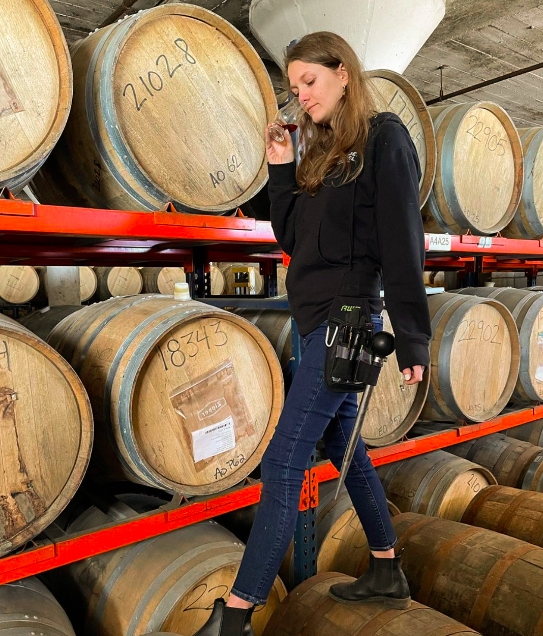
How much room do you have to create new expressions while you’re doing this work? You must find some honey barrels and pleasant surprises along the way.
Our team is very intentional about our special releases. Those are pretty mapped out and by using our Whisky System, we’re getting very specific casks. I think it would be rare to stumble across a group of really unique casks that we decide to make a release out of it. All of our special offerings are very pre-planned, and intentional, and have a purpose.
But we do have the opportunity for that with single barrels. There will be moments when one of us comes across a cask that we really love. At that point, we will kind of pass it around and have a bunch of different people try it. If the enthusiasm is there, we will show it to Alex, who manages our single barrel program, and he will decide whether there’s space for that on the single barrel list. At times, too, we will just pump it straight to the front of the house as a single barrel.
So while Alex’s single barrel list is separate, sometimes there will be one specifically that’s just like, “Oh my gosh, this is beautiful. We want to showcase this in our tasting room.” There’s always space for that, which has been really fun, as well.
Let’s wrap up by talking about what inspires you in the whiskey world. Which whiskeys are you drinking where you’re like, “Oh, this is excellent,” and it’s something that drives you and excites you?
I really love that question. Do you mind if I answer it two ways?
Go for it!
Personally, I am really inspired when I’m drinking like Compass Box. I love blending, and I think the category of blends is fascinating. When I drink Compass Box, I just think about the creation there and taking so many different parts and creating this beautiful full picture. I’ve never been disappointed by a release I’ve tried from Compass Box.
Same.
I think what they’re doing, creating these luxury blends, I think it’s very much honoring a category that really had its heyday decades ago. People were drinking blends and then single malt kind of took over. I just admire that they are paying so much respect to this category that sometimes gets a bad name. Because it’s blending, they’re creating blended whiskeys. But it’s still part of what we’re doing in-house when we’re mixing our own barrels together. It’s just nice to sip one of their whiskeys and think about all of the parts that went into it, traveling, sampling different tasks from different distilleries, and figuring out what might work…The kind of risk they’re always taking.
I’m also loving exploring blended whiskey and the American independent bottlers and blending houses who are doing that, as well. At Crowded Barrel, we had the Alliance series and we sourced single barrels from all over Texas and did independent bottlings. We also helped with the Texas Whiskey Festival blend. We were like the house distillery that brought everyone together to work on those blends. I also love Lost Lantern. The whole independent bottling and blending scene is very inspiring.
For more of a work-related and second part of my answer, in my day-to-day life here at Balcones what is inspiring me especially is there’s been a lot of talk about intentionality and aspiration and that every whiskey needs to have a reason to exist.
Oh, interesting.
I feel like this goes in part with your earlier question about how whiskey is made from start to finish. That idea and that intention is the key point, and that’s the beginning point. More and more I hear our blending team talking about this intentionality in Balcones and what we are here for. We are seriously asking each other, “Who are we in this industry and what are we contributing?”
I think when we talk about Texas whiskey, there’s so much room for growth. We’re celebrating 15 years this year. Compared to the rest of the world’s whiskey industries, like Scotch and Irish whiskey, we’re babies. One of the things that I’ve really been inspired by is this kind of long-term project we’re doing with large-format casks. It’s helping us peer through the telescope of Texas whiskey and see what Texas whiskey can be capable of when it’s given 10, or 12 years in a cask.
What are you finding with that?
By increasing our cask size, we’re getting a different whiskey volume to surface area of the stave ratio. We’re projecting that our evaporation rate is going to greatly decrease, and it’s going to allow our spirit to kind of settle in the cask for a longer period of time without the same risk of extracting too intensely compared to what we’re hoping to get. We’re hoping to be able to keep the stock in barrels for 8, 10, or 12 years and see what happens when the whiskey in Texas is allowed to settle for longer.
That is fascinating.
We just don’t know. We don’t know entirely what Texas could be in all the different forms of aging and maturation. So, just intention and really having a purpose behind what we’re doing instead of just doing the next cool thing really speaks to me a lot. And I didn’t realize how intensely I was stumbling into that when I got hired here. I knew Gabe and Jared, but I didn’t realize this level of intentionality they had, and I really admire it. That’s been inspiring me at work. It’s just this, every whiskey needs to have a reason to exist and that purpose is what drives us.
